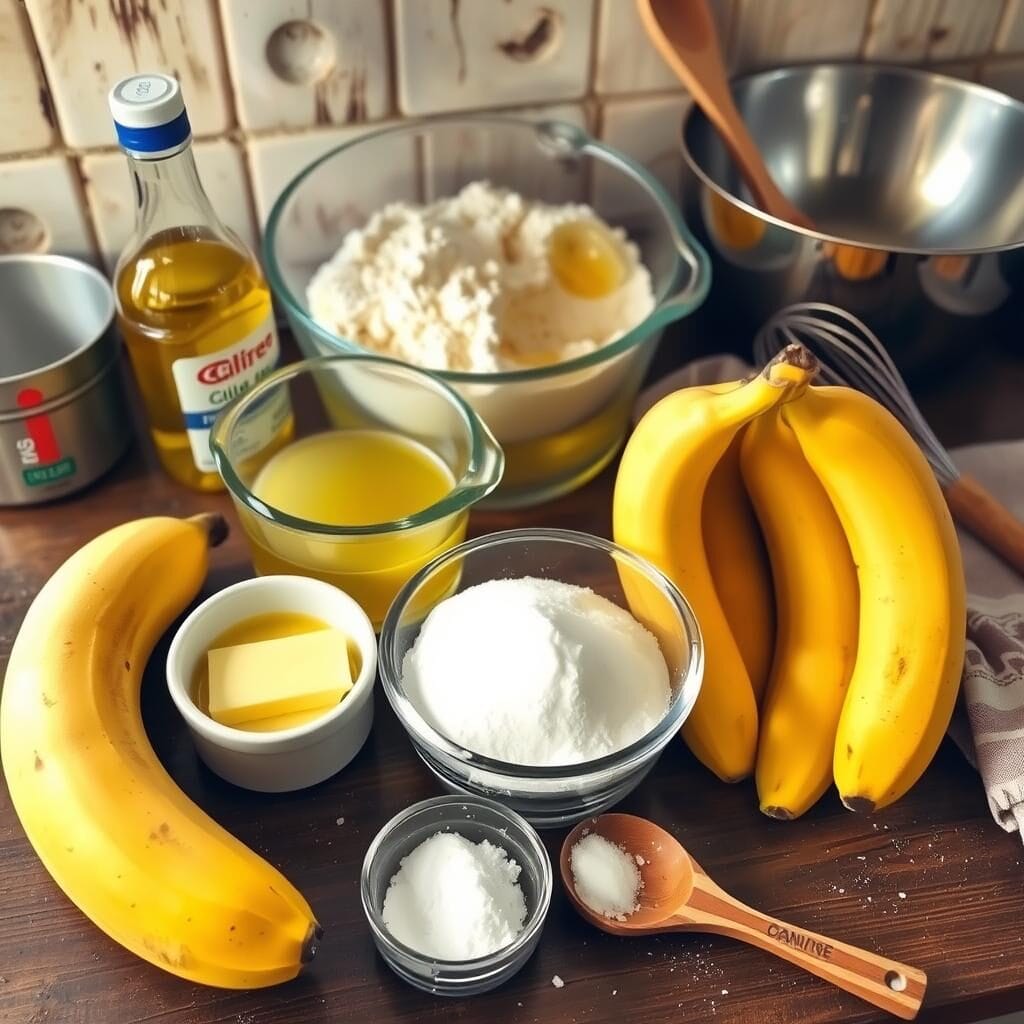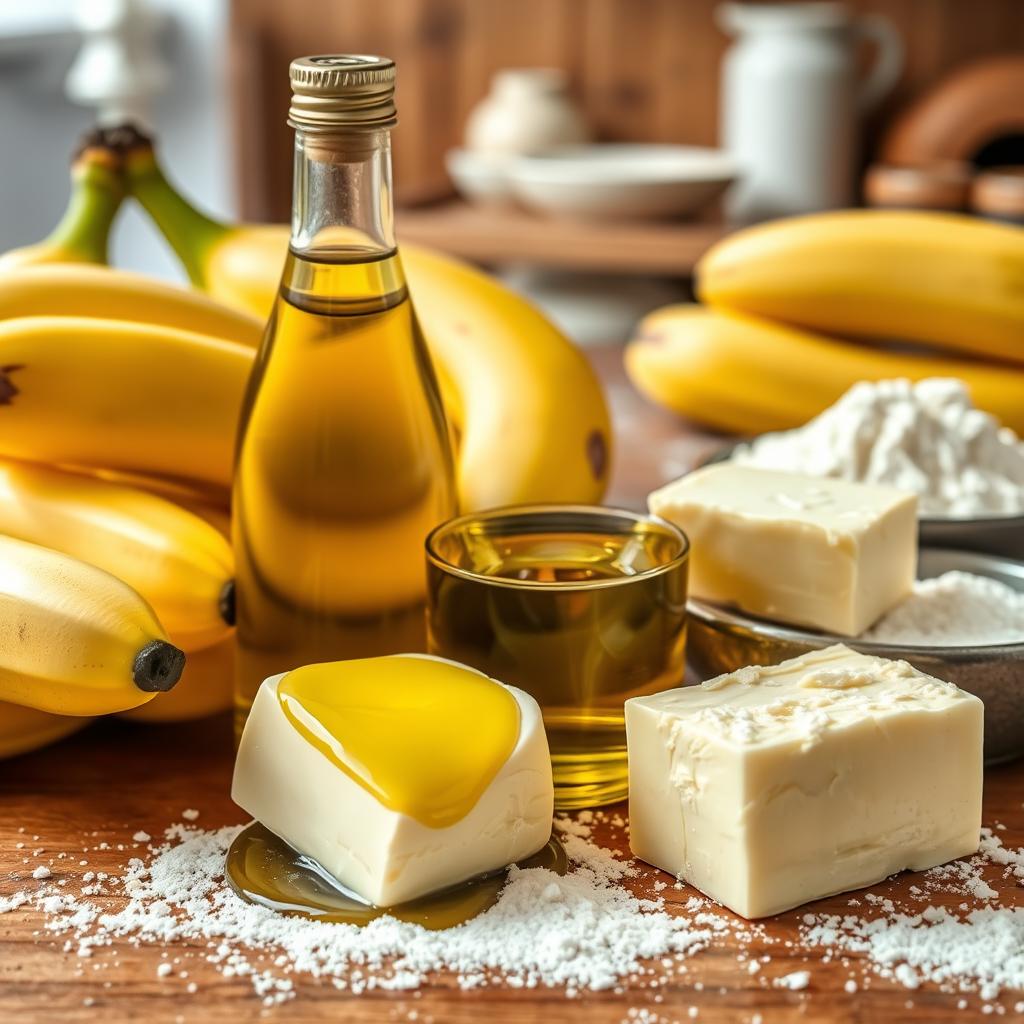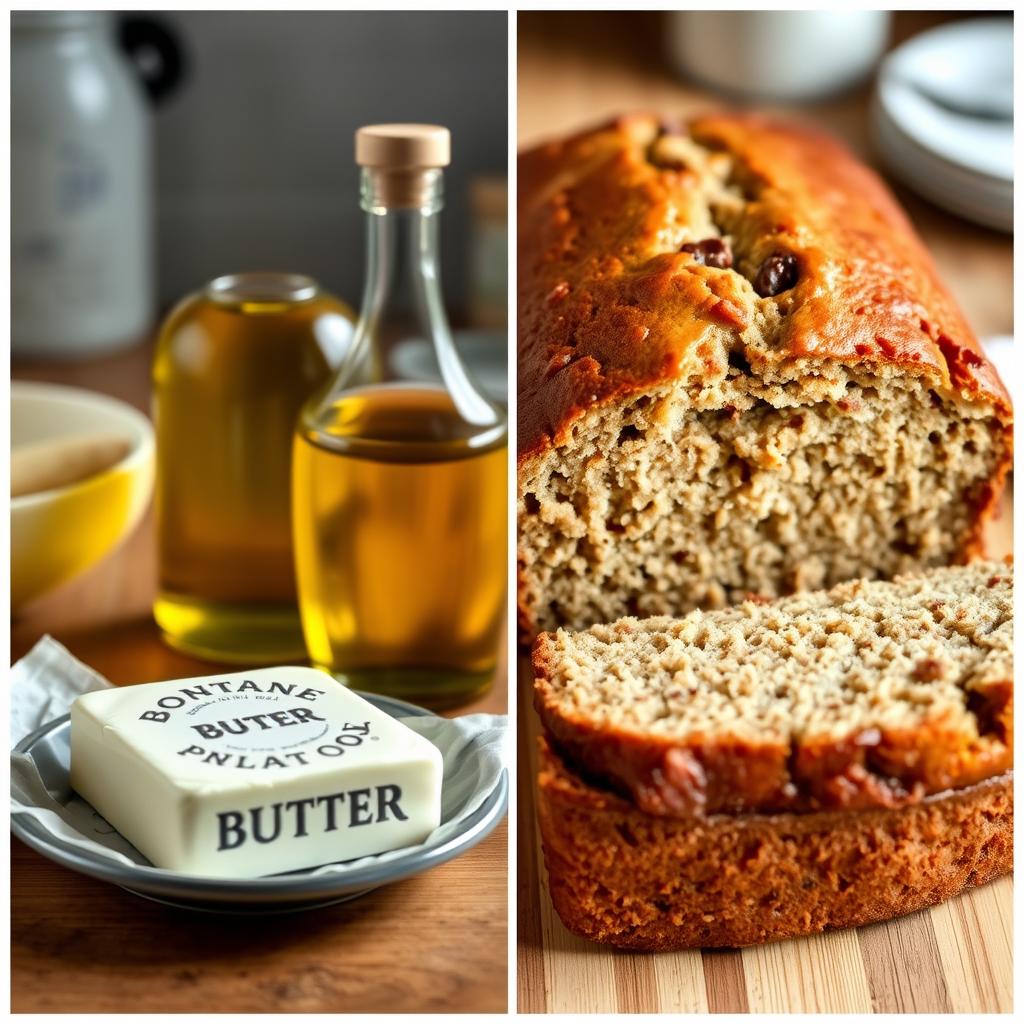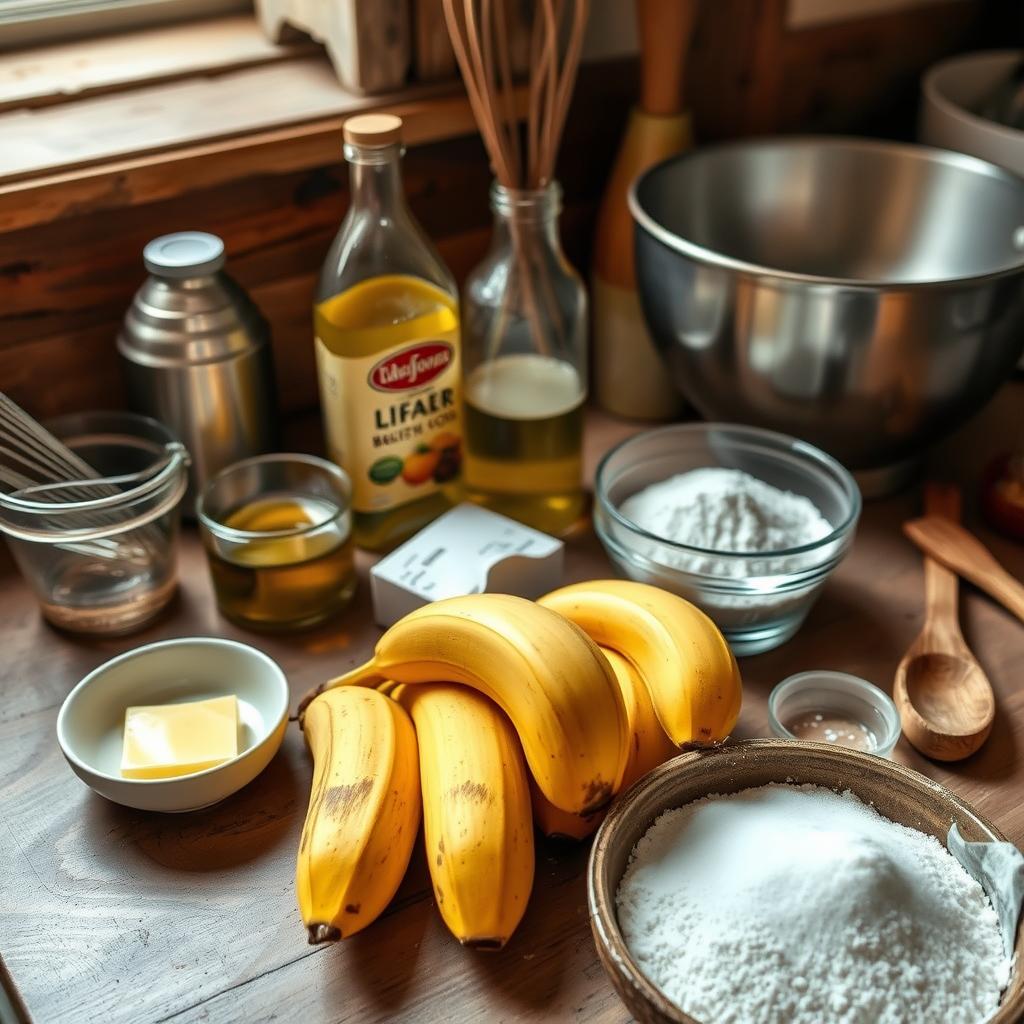Is oil or butter better for banana bread? The smell of banana bread baking is irresistible, but the debate between oil and butter is ongoing. As a home baker, I’ve tried both to find the best recipe.
This guide will compare oil and butter in banana bread. We’ll look at how each affects texture, flavor, and moisture. Whether you’re new to baking or experienced, you’ll learn what to choose for your dream banana bread.

Key Takeaways
- Butter and oil both play crucial roles in the structure and flavor of banana bread, but they have distinct effects.
- Butter provides a rich, creamy taste and tender crumb, while oil offers a more moist and dense texture.
- The choice between oil and butter depends on your personal preferences and the desired outcome for your banana bread.
- Properly measuring and adjusting the fat content is essential when converting a recipe from butter to oil or vice versa.
- Considering factors like shelf life, storage, and health benefits can also help you decide which fat is best for your banana bread baking needs.
Understanding Fats in Banana Bread Baking
Baking banana bread is all about the fats you use. Knowing how fats work in quick breads helps you make better choices. This knowledge ensures your banana bread turns out just right.
Role of Fats in Quick Breads
Fats like oil or butter are key in banana bread. They do several important things:
- They add moisture and make the bread tender.
- They make the bread richer and more enjoyable to eat.
- They help mix in air, making the bread light and fluffy.
- They affect the bread’s color and look.
Chemical Reactions During Baking
When banana bread bakes, fats go through changes. These changes are important for the final product. They include:
- Fats melt and spread out in the batter.
- They mix with flour and eggs to create a stable mix.
- They break down when heated, adding new flavors and smells.
Impact on Flavor Development
The fat you choose can change how your banana bread tastes. Butter gives a rich, creamy taste. Oils let the banana flavor stand out more.

“The right choice of fat can make or break the flavor and texture of your banana bread.”
Knowing how fats work in banana bread helps you pick the best one. This ensures your bread is moist and delicious.
The Classic Butter-Based Banana Bread
Butter is a key ingredient in traditional banana bread. It adds to the bread’s texture and taste. Butter’s creamy richness is why many bakers choose it for banana bread.
Butter makes banana bread moist and tender. It coats the flour, preventing it from becoming tough. The butter also adds a rich flavor that enhances the bananas’ sweetness.
However, using butter has some downsides. Butter-based breads can be denser than those made with oil. Also, butter’s saturated fat can affect how long the bread stays fresh.
“Butter-based banana bread is the classic, indulgent choice that delivers a rich, moist crumb and irresistible flavor.”
Despite these issues, many still prefer butter-based banana bread. Its unique texture and flavor make it a favorite among bakers.

Using Oil in Banana Bread: Modern Approach
The way we make banana bread is changing. Now, people are using oil instead of butter. This change is good for those who care about their health and want to try something new.
Types of Oils Suitable for Baking
Choosing the right oil is key when baking with oil. Here are some great options for banana bread:
- Vegetable oil: It’s affordable and has a neutral taste that works well in baking.
- Canola oil: It’s low in bad fats and has a mild taste that goes well with banana bread.
- Coconut oil: It adds a hint of tropical flavor but can be pricier.
- Avocado oil: It has a high smoke point and makes baked goods creamy and rich.
Benefits of Oil-Based Recipes
Using oil instead of butter in banana bread has many benefits:
- It makes the bread more moist and tender.
- Oil-based bread stays fresh longer, which is great for meal prep and storage.
- Oils can handle higher temperatures better than butter, giving you more flexibility in baking.
Best Oil Options for Banana Bread
For the best banana bread with oil, try these options:
| Oil Type | Key Benefits |
|---|---|
| Vegetable Oil | Affordable, neutral flavor, and excellent for moisture retention. |
| Canola Oil | Heart-healthy, low in saturated fat, and complements banana flavors. |
| Coconut Oil | Imparts a subtle tropical aroma and rich, creamy texture. |
Exploring oil in banana bread opens up a new world of flavors and textures. It’s a fresh take on a classic quick bread.
Is Oil or Butter Better for Banana Bread?
Choosing between oil or butter for banana bread can greatly affect the taste and texture. Each has its own benefits that can change how your banana bread ingredients turn out. Let’s look at the good and bad of each to help you decide.
Butter-Based Banana Bread
Butter is a favorite for banana bread because it adds a creamy texture and a buttery taste. It also makes the bread tender and moist. But, butter can dry out the bread if it’s not stored right.
Oil-Based Banana Bread
Oil makes banana bread moist and tender, lasting longer than butter-based bread. Oils like vegetable or canola oil keep the bread moist because they’re liquid at room temperature. Plus, oils don’t overpower the banana flavor.
| Butter | Oil |
|---|---|
| Rich, creamy texture | Moist, tender texture |
| Distinct buttery flavor | Neutral flavor |
| Can dry out over time | Retains moisture better |
Whether to use oil or butter for banana bread depends on what you like. Try both to see which one you and your family prefer.
Moisture Content: Comparing Oil vs Butter
The choice between oil and butter in banana bread matters a lot. It affects how moist and tasty your bread will be. Knowing how these fats work is key to making the best banana bread.
Storage and Shelf Life Differences
Banana bread with oil keeps better and stays moist longer than butter-based ones. Oils don’t lose moisture as quickly as butter does. So, oil-based breads last longer and stay fresher.
Temperature Effects on Moisture
Temperature changes can also affect your banana bread’s moisture. Oil-based loaves stay moist in warm places because the oil stays liquid. But, butter-based breads can get dry and crumbly in heat, as the butter melts.
To keep your banana bread moist, wrap it in plastic or foil after it cools. Or, store it in an airtight container. This helps keep the moisture in banana bread and makes it last longer.
Understanding how butter or oil for moist banana bread impacts moisture is important. It helps you choose the right fat for the perfect banana bread texture and taste.
Texture and Crumb Structure Differences
Choosing between oil and butter can greatly affect your banana bread’s texture and crumb. Knowing these differences helps you get the perfect mouthfeel and density in your quick breads.
Oil-based banana bread is moist and tender, with a light and airy texture. Without solid fat, the batter spreads air evenly. This makes the bread soft and delicate.
Butter-based banana bread is denser and more substantial. The solid fat in the batter makes the bread robust and slightly coarser. This texture is great for a tender-yet-sturdy banana bread slice.
| Texture Characteristic | Oil-Based Banana Bread | Butter-Based Banana Bread |
|---|---|---|
| Crumb Structure | Lighter and airier | Denser and more substantial |
| Mouthfeel | Moist and tender | Firm and sturdy |
| Slicing | Delicate and may be more prone to crumbling | Holds its shape better when sliced |
Whether to use oil or butter for banana bread depends on your taste and texture preferences. Try both fats to find the one that fits your baking style and pleases your palate.
Flavor Profiles: How Fat Choice Affects Taste
Choosing between oil and butter in banana bread changes the taste a lot. Knowing how each fat affects the flavor is key to making a delicious loaf. It’s all about finding the right balance of sweet banana flavors.
Butter’s Distinct Flavor Contribution
Butter makes banana bread taste richer and creamier. Its milkfat adds a dairy flavor that goes well with bananas. This mix of flavors is why many love using butter in their banana bread.
Oil’s Neutral Impact on Taste
Oils like vegetable, canola, or sunflower oil don’t add much flavor. They let the banana’s taste stand out. This is great for those who want a simple, banana-only taste in their bread.
So, whether you choose oil or butter, it’s all about what you like. Do you want a classic buttery taste or a clean banana flavor? Knowing how fats affect taste helps you make the perfect banana bread every time.
Health Considerations When Choosing Fats
Choosing between oil and butter for banana bread affects your health. It’s important to know the nutritional differences. This helps you pick what’s best for your diet and taste.
Butter adds a creamy flavor to banana bread. Yet, it has more saturated fats. These fats can raise heart disease risk if eaten too much. Using oil instead can be a healthier banana bread fat option.
Oils like olive, canola, or avocado are better for your heart. They have less saturated fats and more unsaturated fats. By substituting oil for butter in banana bread, you get a tasty loaf with fewer calories and fats.
| Nutritional Comparison | Butter | Vegetable Oil |
|---|---|---|
| Calories (per tablespoon) | 102 calories | 124 calories |
| Total Fat | 11.5 g | 14 g |
| Saturated Fat | 7.2 g | 1.9 g |
| Unsaturated Fat | 3.3 g | 12.1 g |
Knowing about healthier banana bread fat options helps you choose wisely. This way, you can enjoy banana bread while keeping your health in mind.
“Choosing the right fat can make a significant difference in the nutritional profile of your banana bread, allowing you to indulge in a delicious treat while prioritizing your health.”
Making the Switch: Converting Butter to Oil Ratios
When baking banana bread, swapping butter for oil is a big step. It’s about understanding how to adjust measurements and recipes. This skill can open up new flavors and healthier options in your kitchen.
Measurement Guidelines
For substituting oil for butter, use a 3:4 ratio. If a recipe asks for 1 cup of butter, use 3/4 cup of oil. This keeps your banana bread moist and right in texture.
Recipe Adjustments
- When using oil instead of butter, you might need to cut down on milk or eggs. This prevents the batter from getting too runny.
- Adding a bit more baking soda or powder can help your oil-based banana bread rise. It makes it light and fluffy.
- Also, you might need to adjust the baking time and temperature. Oil-based breads often take longer to bake at a lower temperature.
With these tips, you can easily switch your banana bread recipe from butter to oil. This lets you explore different flavors and textures.
Success in oil-to-butter swaps comes from precise measurements and a bit of experimentation. With practice, you’ll soon make delicious, moist, and tasty oil-based banana bread.
Tips for Perfect Banana Bread Regardless of Fat Choice
Baking the perfect banana bread, whether you use oil or butter, requires a few key techniques. Follow these expert tips to ensure consistently delicious results every time.
Prepare Ingredients Properly
- Mash overripe bananas thoroughly to achieve a smooth, lump-free consistency.
- Bring all refrigerated ingredients, like eggs and butter, to room temperature before mixing.
- Measure dry ingredients carefully using the spoon and level method to prevent overpacking.
Mix with Care
- Use a light hand when combining the wet and dry ingredients to avoid over-mixing, which can result in a tough, dense crumb.
- Fold in any add-ins, like nuts or chocolate chips, gently to preserve their texture.
- Pour the batter into the prepared pan and smooth the top to ensure even baking.
Bake at the Right Temperature
Regardless of whether you use oil or butter, bake your banana bread at 350°F (175°C) for 55-65 minutes, or until a toothpick inserted in the center comes out clean. This temperature strikes the perfect balance between a golden crust and a moist, tender interior.
| Baking Tip | Benefit |
|---|---|
| Prepare ingredients properly | Ensures consistent results and well-developed flavors |
| Mix with a light hand | Prevents a tough, dense crumb |
| Bake at 350°F (175°C) | Achieves the perfect balance of crust and moisture |
By following these simple tips, you can create moist, flavorful banana bread regardless of whether you choose to use oil or butter in your recipe. With a little attention to detail, you’ll be baking up bakery-quality banana bread in no time.
Conclusion
The choice between oil and butter in banana bread comes down to what you like. Each has its own benefits that affect the bread’s texture, moisture, and taste.
Oil makes the bread moist and tender, letting the banana flavor stand out. On the other hand, butter adds a richer taste. It brings out the sweetness of bananas.
It’s all about finding what you like best. Try both to see what works for you. The debate over oil or butter is personal. So, trust your taste and enjoy experimenting to find your favorite banana bread. Happy baking!

